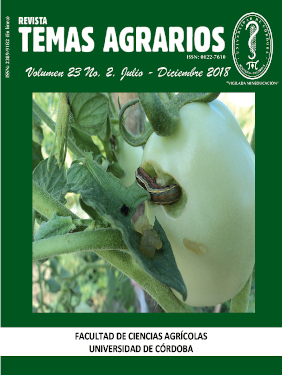Analysis of benefic entomofauna in transgenic and conventional corn crops, Córdoba-Colombia
Analisis de la entomofauna benéfica en cultivos de maíz transgénico y convencional, Córdoba-Colombia
How to Cite
Sanchez, M. L., Linares, J. C., Fernández Herrera, C. R., & Pérez García, K. D. (2018). Analysis of benefic entomofauna in transgenic and conventional corn crops, Córdoba-Colombia. Sour Topics, 23(2), 121-130. https://doi.org/10.21897/rta.v23i2.1296
Dimensions
license

This work is licensed under a Creative Commons Attribution-NonCommercial 4.0 International License.
Show authors biography
Article visits 1448 | PDF visits
Downloads
Download data is not yet available.
- Benamú, M. 2010. Composición y estructura de la comunidad de arañas en el sistema de cultivo de soja transgénica. Tesis de Doctorado, Facultad de Ciencias Naturales y Museo, Universidad
- Nacional de La Plata, Argentina pp. 120.
- Berry, N., Wratten, S., McErlich, A. y Frampton, C. 1996. Abundance and diversity of beneficial arthropods in conventional and “organic” carrot crops in New Zealand. New Zealand Journal of Crop and Horticultural Science 24: 307-313.
- Borror, D. and White, R. 1998. A field guide to insects: America north of Mexico (Vol. 19). Houghton Mifflin Harcourt.
- Casanoves, F., Pla, L. y Di Renzo, J. 2011. Valoración y análisis de la diversidad funcional y su relación con los servicios ecosistémicos. Turrialba, CR. CATIE. 84pp.
- Chao, C. and Jost, L. 2012. Coverage-based rarefaction and extrapolation: standardizing samples by completeness rather than size. Ecology, 9:2533-2547.
- Chaves, D., Martins, S., Maruccib R., De Carvalho, A., Matoso, M. and Magid, J. 2016. Does Bt maize cultivation affect the non-target insect community in the agro ecosystem?. Revista Brasileira de Entomologia 60; pp. 82–93.
- Conner, A., Glare, T., Nap, J. 2003. The release of genetically modified crops into the environment - Part II. Overview of ecological risk assessment. The Plant Journal 33: 19–46.
- Corpoica. 2012. Aproximación metodológica del proyecto Lac biosafety para evaluar efectos sobre especies no objetivo: Caso del maíz Bt. pp 94.
- Dively, G. 2005. Impact of transgenic VIP3A Cry1Ab Lepidopteran-resistant fieldcorn on the nontarget arthropod community.
- Environ. Entomol. 34, 1267–1291.
- Feinsinger, P. 2003. El diseño de estudios de campo para la
- conservación de la biodiversidad. FAN (Fundación Amigos de la Naturaleza), Santa Cruz de la Sierra, Bolivia. 242 p.
- Fernández, F. y Sharkey, J. (eds.). 2006. Introducción a los Hymenoptera de la Región Neotropical. Sociedad Colombiana de
- Entomología y Universidad Nacional de Colombia, Bogotá D. C., 894 pp.
- Greenstone, M. 1999. Spider predation: How and why we study it. Journal Arachnology. 27: 333-342.
- Hilbeck, A., Moar, W., Pusztai-Carey, M., Filippini, A. and Bigler, F. 1999. Prey-mediated effects of Cry1Ab toxin and protoxin and Cry2A protoxin on the predator Chrysoperla carnea. Entomol. Exp. Appl. 91: 305–316.
- Jost, L. 2006. Entropy and diversity. Oikos, 113:363-375.
- Lobos, E. 2003. Evaluación de la fauna benéfica en cultivos de algodón convencional y transgénicos con expresión de la toxina del Bacillus thuringiensis. INDEAS-Facultad de Agronomia y Agroindustrias -UNSE. Av. Belgrano 1912- 4200 Santiago del Estero- Argentina.
- Magurran, A. 1998. Ecological biodiversity and its measurement. Princenton University Press, New Jersey. 179 p.
- Marvier, M., McCreedy, C., Regetz, J. and Kareiva, P. 2007. A meta-analysis of effects of Bt cotton and maize on nontarget
- invertebrates. Science 316: 1475–1477.
- Meissle, M. and Romeis, J. 2012. No accumulation of Bt protein in Phylloneta impressa (Araneae: Theridiidae) and other arthropods in Bt maize. Environ. Entomol. 41,1037–1042.
- Moreno, C., Barragán, F., Pineda, E. and Pavón, N. 2011. Reanalyzing alpha diversity: alternatives to understand and compare information about ecological communities.
- Nájera, R. y Souza, B. 2010. “Insectos benéficos. Guía para su identificación”. Edición del Instituto Nacional de Investigaciones
- Forestales, Agrícolas y Pecuarias (INIFAP) y la Universidad Federal de Lavras (UFLA), Minas Gerais, Brasil. Noviembre.
- Naranjo S. 2005. Long-term assessment of the effects of transgenic Bt cotton on the function of the natural enemy community. Environmental Entomology 34: 1211–1223.
- O’Callaghan, M., Glare, T., Burgess, E. y Malone, L. 2005. Effects of
- plantsgenetically modified for insect resistance on non-target organisms. Annu. Rev.Entomol. 50, 271–292.
- Pérez, G., Tamajón, R., Aldebis, H. y Vargas O. 2009. Comunidad de arañas en cultivos de algodón ecológico en el sur de España.
- Rev. Colom. Entomol. 35: 168-172.
- Riechert, S. and Lawrence, K. 1997. Test for predation effects of single versus multiple species of generalist predators: Spiders and their insect prey. Entomology Exp. Applic. 84: 147-155.
- Rohlf, F. and Sokal, R. 1981. Biometry: the principles and practices of statistics in biological research. 2nd Ed., W.H. Freeman, San Francisco. pp. 321–371
- Romeis, J., Meissle, M., Naranjo, S., Li, Y. and Bigler, F. 2014. The end of a myth – Bt(Cry1Ab) maize does not harm green lacewings. Front Plant Sci 5, 1–10.
- Schuler, T., Potting, R., Denholm, I. and Poppy, G. 1999. Parasitoid behavior andBt plants. Nature 400, 825–826.
- Triplehorn, C. and Johnson, N. 2005. Borror and DeLong’s Introduction to the Study of Insects. Belmont, CA: Thomson Brooks/Cole.
- White, J. and Andow, D. 2005. Host–parasitoid interactions in a transgeniclandscape: spatial proximity effects of host density.
- Environ. Entomol. 34,1493–1500.




















